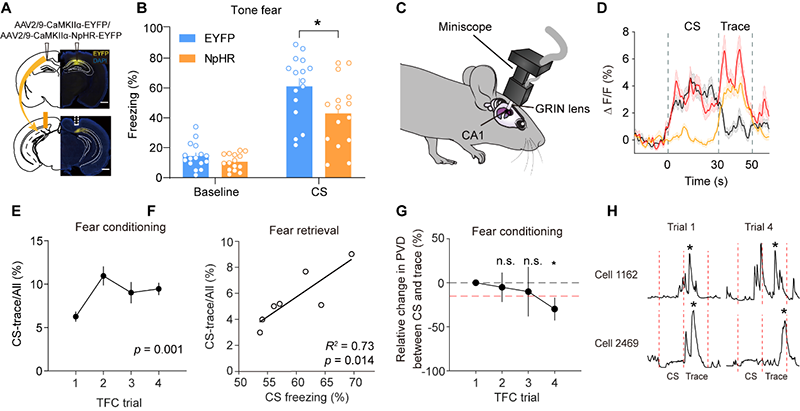Time:2023-07-26
The laboratory of Dr. XU Chun at the Institute of Neuroscience, Center for Excellence in Brain Science and Intelligence Technology of the Chinese Academy of Sciences, State Key Laboratory of Neuroscience, revealed neural mechanisms underlying associative learning of discontinuous events and demonstrated the critical role of the hippocampal CA1-Subiculum circuit in trace fear conditioning by combining behavioral analysis, optogenetics, and Calcium imaging.
Both CA1 and Subiculum areas were found to play critical roles in maintaining and transmitting stimulus information during the trace period between discontinuous events, but only CA1 was found to be essential in the formation and storage of fear memory after learning. This work provides new insights for understanding the neural mechanisms underlying associative learning and memory formation.
In real-life situations, sequential events occurring in close succession could form associative memories. In the classical delay fear conditioning (DFC) paradigm, the conditional stimulus (CS, e.g., sound) and unconditional stimulus (US, e.g., foot-shock) are delivered without any time gap. In contrast, the trace fear conditioning (TFC) paradigm introduces a time interval (a few seconds to several tens of seconds), known as the "trace", between CS and US, and is commonly used to study the neural mechanisms of associative learning involving discontinuous events. The longer the trace is, the more difficulty for successful associative learning is. Thus, the TFC requires more cognitive demands such as working memory and time representation, and is also used for cognitive testing in neurodegenerative diseases and psychiatric disorders.
In this study, the authors performed optogenetic terminal inhibition of CA1-to-Subiculum pathway and found that the associative learning of CS and US was impaired (Figure 1A-B). Using head-mounted miniscope, researchers recorded Ca2+ signals from excitatory neurons in CA1 and subiculum throughout the process of trace fear conditioning and observed sustained neural activity in both regions after the CS ended (Figure 1C-D). During the fear learning, the number of neurons in CA1 and Subiculum that responded to CS and trace increased, with those in CA1 showing a positive correlation with fear memory strength (Figure E-F).
Populational analysis revealed that neuronal activity of CA1 neurons during the CS and trace periods became more and more similar during the TFC, suggesting a better CS information maintenance in the trace period. Furthermore, the peak activity timing of CA1 and Sub neurons during the trace period gradually delayed and shifted towards the US onset, allowing for successful association with the US (Figure 1H).

Figure 1: CA1-Sub circuit is essential for trace fear conditioning. (A&B) Optogenetic inhibition of the CA1-Sub axon terminals impaired the association of CS and US in TFC. (C&D) Freely moving head-mounted Calcium imaging in the hippocampus identify significant neural activity during the CS and trace periods. (E&F) The proportion of CA1 neurons responding to both CS and trace increased during learning and correlated with the strength of memory formation. (G) CA1 populational activity during the trace period becomes more similar to that in the CS period. (H) Peak activity timing of CA1 neurons during the trace period delayed and shifted closer to the US.
The US serves as a reinforcer for associative learning. The authors found that the number of US responsive cells in CA1 increased gradually during learning and correlated with the strength of fear memory formation. In contrast, no such changes were found in Subiculum (Figure 2A-E). Clustering of CA1 and Sub neurons based on their US responses showed that CA1 neurons had more US responsive cells with stable responses (Figure 2E-F), suggesting US-driven associative memory formation in CA1.

Figure 2: Distinct US responses in CA1 and Sub vs. fear memory formation. (A&B) The proportion of CA1 neurons responding to US increased during TFC and correlated with fear memory formation. (C&D) The proportion of US responsive neurons in Sub did not correlate with fear memory formation. (E) Clustering of CA1 neurons based on their US responses. (F) The proportion of CA1 cells showing stable responses to US is higher than that of Sub cells.
In conclusion, this line of research highlights the critical roles of the CA1-Subiculum circuit in associative learning of discontinuous events. These findings demonstrate the hippocampal circuit mechanism underlying associative learning of discontinuous events.
This work entitled “Learning-prolonged maintenance of stimulus information in CA1 and Subiculum during trace fear conditioning” was published online in Cell Reports on July 22, 2023. The corresponding author of this paper is Dr. XU Chun from the Institute of Neuroscience, Center for Excellence in Brain Science and Intelligence Technology of the Chinese Academy of Sciences. BAI Tao, a doctoral student, is the first author of the paper. Research assistants ZHAN Lijie, ZHANG Na, and LIN Feikai have made significant contributions to this project. This study received funding support from the Ministry of Science and Technology, National Natural Science Foundation of China, Chinese Academy of Sciences, Shanghai Municipal Government, and Lingang Laboratory.
Keywords: Trace fear conditioning, Neural plasticity, Learning and memory, Hippocampus, Ca2+ imaging, Optogenetics
 Link: https://www.sciencedirect.com/science/article/pii/S2211124723008641
Link: https://www.sciencedirect.com/science/article/pii/S2211124723008641
PMID: 37481720 DOI: 10.1016/j.celrep.2023.112853
AUTHOR CONTACT:
XU Chun
Institute of Neuroscience, Chinese Academy of Sciences, Shanghai, China.
Phone: 86.21.5492.1916; E-mail: chun.xu@ion.ac.cn
Lab webpage : http://english.cebsit.cas.cn/lab/xuchun/research/
 附件下载:
附件下载: